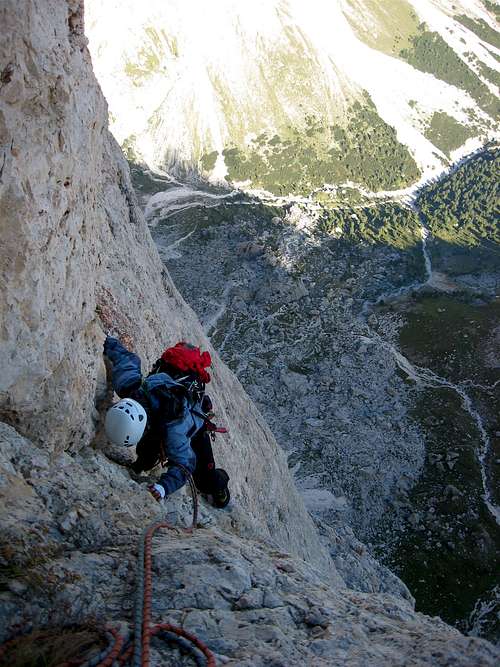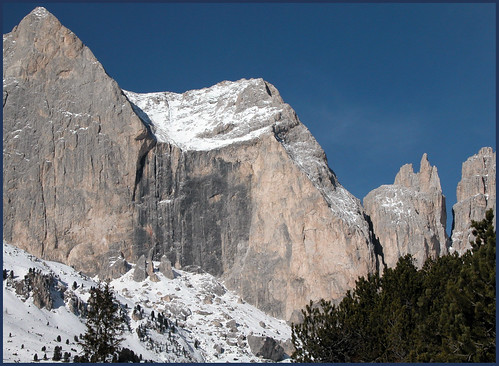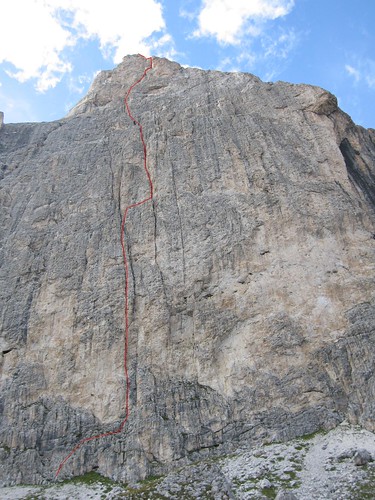Rosengartenspitze, Ostwand "Steger" and Punta Emma "Fedele"
Friends: AdrianLocation: Rosengartenspitze
Elevation gain: 1300m = 1300m
Alas, no pictures! I forgot the camera at home! But I do have some iPod Nano footage (shaky)
Adrian and I made a weekend trip to the Dolomites. His girlfriend Traudi came along with us to get some relaxation in beautiful scenery while we climbed. We drove down Friday afternoon, and after renting a taxi to the Gardecci Hut, walked in the moonlight up to the Vajolet hut, where Pete and I stayed during our June trip to the area. We had two bottles of wine and potato salad with potatoes from Traudi's family farm in Romania. Delicious!
The next morning, after breakfast, we hiked to the base of the route. Two other guys were in front and we figured our job would be easier because we could follow them for route confirmation. That didn't really work out as planned, however. As we got ready, a multitude of other parties converged at the base. I scrambled up the easy first "pitch," to get in line just in front of a party of three nice Italians, who we would see on and off throughout the day.
Adrian took the first lead, a steep pitch generously endowed with holds to keep the grade down. He belayed 50 meters up at the base of a steep corner that had the crux moves of the climb (pitch 4 on the topo). I followed and led through the crux, finding it most difficult where I needed to place a large cam in an overhanging corner before traversing off right and up to a steep but crumbly face. Adrian followed, then led up through a surprisingly difficult wall up and left of the belay, which we estimated to be as hard as the crux moves below. Later, a look at the topo revealed an easier way up a white wall above the belay that lookd holdless, but actually had big, camoflaged grips. From here, we continued a couple of pitches wondering exactly where we were. The problem was that terrain was not difficult, providing many options, and indeed, the wall is festooned with old pins and slung belay stances. Losing the route is common in here!
I led easily up into a corner, then by a slung "sanduhr" (hourglass) traversed left across a small face to then climb a rapidly easing corner to a stance. I knew that the route makes a devious gentle traverse rightward in this area, but neither we nor the party of three below could figure out where it was, despite 2 topos and one italian detailed pitch description. I was cautious because a friend had already spent a night out in a cave on the face due to an error here. Adrian led off, inclined to follow the two climbers above, though they seemed to be getting off route by going straight up a black crack that one topo writes "NEIN!" over! Adrian searched for the right way, knowing he should go right but not sure exactly how or where. Finally he settled on a traverse of a difficult face, emerging on a ledge that, to me and the Italians below, looked like nirvana: a perfect belay ledge. But Adrian found only a few edelweiss plants. The Italians started up and found the proper ledge 10 meters higher than Adrian. Now he had the unenviable task of reversing his route, cleaning cams and nuts along the way. He did this, and climbed up to the proper belay. It was costly, but overall, time well spent because the error could have been worse!
Two really nice pitches followed, a IV+ and V, first cracks and face up to the base of a steep corner (and crowded belay, with the Italians), then Adrian led a stellar chimney/crack pitch that marked the halfway point on our topo. Yes!
Three more straightforward pitches led up to the base of another beautiful steep corner crack. Still, it was easy to get lost. The Italians headed off right, missing the key climb behind a massive block in a chimney identified on route maps (fun climbing, too). Later, confused, we ventured right to follow them, then came back to the main line, a little apprehensive about the steep faces they were climbing above! In the lower part of this section I cowered under an overhang as two volleys of highspeed rock fall from high above exploded around me. That distinctive fluttering sound is never easy to hear! Again, Adrian got the V+ corner crack on his lead...I started chiding him for stealing all the hard pitches. It was a really fun ropelength, well protected by cams and the occasional piton.
Two moderate and fun pitches led up and right, closing off options as a smooth yellow face loomed above us. Birds whooshed around the cliff at high speed, and clouds began pouring through the low gap in the range to the south. We caught the Italians again at a belay before the final chimney, perched scenicly above a steep, yellow grade V face. They had had good adventure on a line off to our right, and we'd heard them every now and then around the corner for the previous 4-5 pitches.
I got the last full pitch. We'd put on jackets now, as the clouds through the gap had spread and finally made it over the summit. Adrian, smiling through gritted teeth said: "Please. No delay. Climb. I am cold." More direct words were never spoken! I went up the final bit of the yellow face, then into the chimney, favoring one side and then the other, with the crux moves ascending a hand crack on the right side. Wow, what a pitch! I emerged at a notch in the ridge, seeing the Italians scrambling the summit, coils of rope in their hands. I couldn't find a good gear belay, and finally just wrapped the rope around a section of the ridge. Adrian came up, pleased as punch, then set off on a scramble to the summit. I coiled half the rope and followed to the top. We stood under the cross and offered congratulations all around! There were clouds to block the view of the Gardeccia, but valleys and peaks to the north were visible. Swaths of green ridges were especially impressive, constrasting so greatly with the big yellow and gray bulks embedded into the clouds.
We descended easily to the north, scrambling on a ridge past an unnecessary (in dry conditions) rappel anchor, then reaching a notch in the ridge to make a 50 meter rappel to more scrambling. We passed a hut and continued down to the Vajolet Towers, and then our own hut, just in time for dinner. Traudi said she heard me and my loud voice for 20 minutes coming down the canyon. Oops!
We had a great dinner, and finished with good wine, talk and a much-needed hot shower. I was getting lots of German practice with Traudi, who explained the history of the opera and many other interesting things. Adrian and I resolved to climb the "Fedele" Route on Punta Emma the next day. A short climb, it would allow us to leave early and get home at a decent hour.
Fedele Route, Punta Emma, V-, 11 pitches
I ended up basically scrambling the first pitch (IV+) due to a misreading of the topo, oops! Finally at the end of the pitch I got a decent cam in to protect the final moves up a slabby corner. I led the next pitch too, a really fun V- corner crack. Adrian continued on easier but still interesting terrain to a spot below a distinctive black crack. I climbed up to the crack, placed a solid cam, then traversed left to a line of pitons in a shallow, smooth corner. Amazingly, there was a small hidden hold just where necessary. Clipping the last of three pitons was very awkward, as I was already traversing out of the smooth corner along a line of holds leading left. Now, up and left a long ways for a full 55 meter pitch to a 3 piton belay on the right side of a buttress of imposing black rock, permanently stained by waterfalls in the rainy season. Adrian came up and led an impressive looking pitch with a short overhang directly above my belay. We talked about how Fedele was a genius at finding easy routes up vertical faces, both veterans as we are of the "Fedele/Dibona" monster line on Piz Pordoi, improbably rated grade V. This smaller climb shared the serious feeling of the larger, because of the vertical angle of rock all around you.
Adrian had combined two pitches, leading up into the final black chimney, easily visible from trails below. In a repeat of the day before, I got the final chimney moves, emerging on easy ground 100 meters below the summit. Here we unroped, joking about my decision to climb without a pack (and therefore without food and water). Basically I was tired of climbing with a pack from the day before, and knew this climb was easy enough to allow a break from the alpine traditions. Adrian tried to offer me water, which I gallantly refused. Then he tried to offer me his favorite candy, a "Kinder Pinguino" (children's penguin). When I refused that he called me an unprintable name and all but forced me to accept it. Good fun!
We walked the summit, talking about past and future climbs to do. I remembered being here with Pete two months before, thinking about how he'll be a dad soon. Man, time flies!
Easily down with scrambling and a rappel, then to the hut and down to Traudi, enjoying herself in the beautiful meadows near the Gardeccia Hut. This was an amazing place, with families laying out on the grass, kids running around, all beneath the fantastic towers of the central Rosengarten ridge. It wouldn't have hurt Adrian and I to spend the day here, either.
The taxi and the drive home followed. Big thanks to Adrian and Traudi for driving, companionship and the friendship of the rope!
Detailed pitch descriptions
Rosengarten Ostwand "Steger"
P1 - II, scrambling.
P2,3 - IV+,V, Adrian combined these easily in 50 meters climbing cracks and a yellow corner to a belay in the corner.
P4 - VI-, I led up from the corner to an overhang, then right and up a sometimes-loose yellow face to a belay.
P5 - V+, Adrian led left and up from the belay in some hard moves, then IV+ crack terrain to easier ground and a belay.
P6 - V, Michael led easily up to a corner, then traversed left at a block (good nut) into an easier corner and grade III terrain to a belay on the left of a gully.
P7 - IV+, Adrian, up the gully to then turn right after 25 meters beneath a yellow corner and gain a yellow ramp. By no means continue up the corner or veer left into a black crack ("schwarzer Riss" on german topos).
P8 - IV+, Michael, enjoyable easy but steep climbing up cracks, wandering left then back right to a belay in a corner at the end. 30 m.
P9 - V, Adrian, up a steep crack which widens to a chimney. Climb first on the right then the left wall to reach a nut and Sanduhr (hourglass) belay. 40 m.
P10 - IV+, Michael, Follow a crack straight up into an easy gully. Higher, the gully steepens to offer enjoyable grade IV climbing at it's exit to a nut belay. It's easy to lose the route in the middle of this pitch by veering right. 45 m.
P11 - IV, Adrian. Continue on easy (II) terrain to where the gully gains more definition again and a distinctive huge block is wedged inside. Climb behind the block to a two piton belay. 35 m.
P12 - IV, Michael. Don't be tempted rightward here, continue straight up the chimney/gully where it steepens at a crack, then eases to a belay below an impressive black crack. 35 m.
P13 - V+, Adrian. Climb the crack straight up past some pitons to a belay on a ledge/terrace. 35 m.
P14 - IV, Michael. Follow a ramp up and right in very pleasant climbing with big exposure below, but good holds always at hand. We found a 3 piton belay. 45 m.
P15, 16 - IV, V, Adrian. Clip a piton 2 meters above and right of the belay, then continue up gully/channels (we ignored the topo's idea of going right and around a ridge). Emerge on a yellow face, climbing the easiest line past a few pitons to a spectacular belay with the valley laid out below. 50 m.
P17 - V+, Michael. Finish climbing the yellow face, and into a chimney with the most difficult moves shortly before the exit, in a solid hand crack on the right wall. Belay with gear and slings. 30 m.
P18 - III, Adrian. Climb a last slabby step on low angle ridge to where the ridge melts into a low angle face. 25 m.
From here, scramble to the summit (II, 80 m).
Punta Emma, "Fedele"
P1 - IV+, Michael. Climb steep but grassy face directly below a striking dihedral to a belay at the base of the dihedral. 30 m.
P2 - V-, Michael. Climb the dihedral with good cam and piton protection to a belay where the angle lessons. 25 m.
P3 - IV, Adrian. Climb easy terrain in the gully up and right to a solid crack (IV) and a three piton belay. 40 m.
P4, 5 - V-, IV, Michael. Climb easy ground to the base of an obvious black crack. Look left of the crack for a line of pitons in a shallow black dihedral. Ascend this, then continue left and up, past a two piton belay. I continued up and left to a three piton belay at the right side of a black wall. 55 m.
P6 - V-, Adrian. Climb up enjoyable rock to a piton and exposed moves over a slight overhang. Easily back left and up to a two piton belay. Also possible to continue a bit into the chimney and another good belay. 20-40 meters, depending on option.
P7 - IV+, Michael. Climb the very nice chimney to easier terrain.
From here we scrambled to the summit on grade II terrain.
Pictures!
Nice picture from ukclimbing.com:
Great image from Radek and Shirley's inspiring Dolomite trip of 2008:
Here is a link to the topo in the Köhler/Memmel book (in german).
Bivouacs are not usual, usually because of the devious routefinding. Here is a story with an overnight bivouac, and here is another from a friend of mine.
Here is the page on mountainproject.com.
Here is just a really nice photo of the wall. And another, the route on the far left:
Another picture from Graham with the approximate route:



